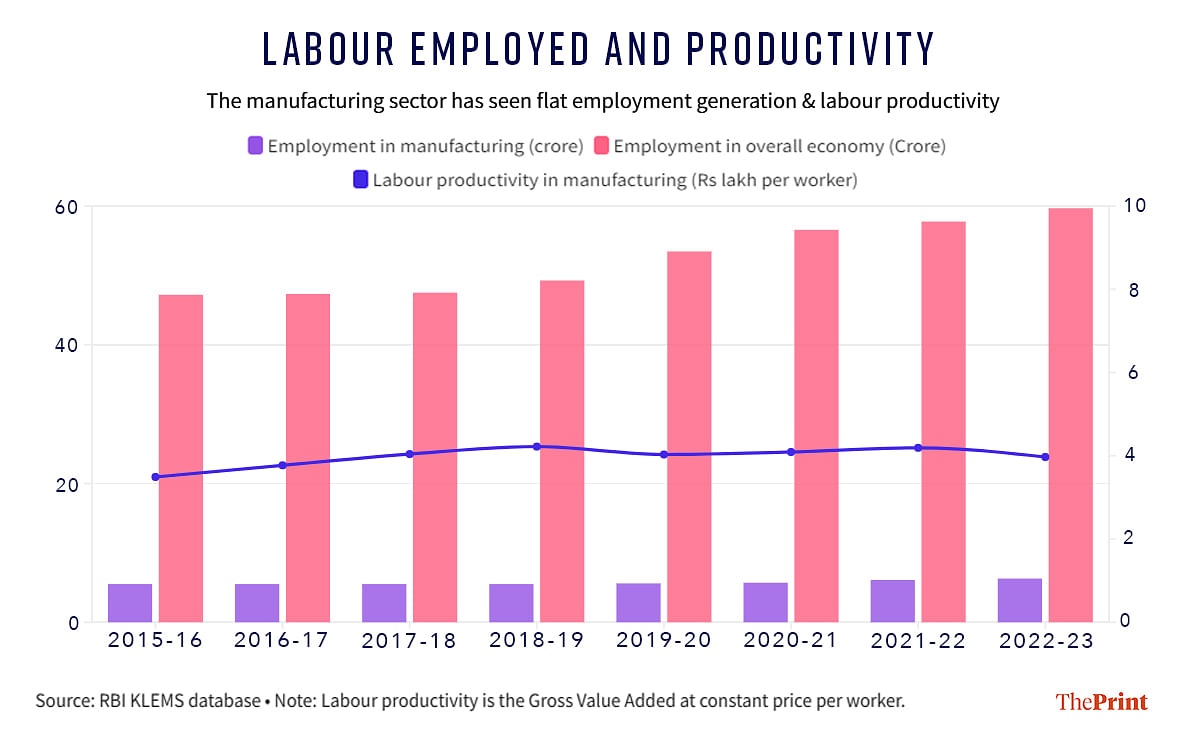New Delhi: India’s manufacturing sector has been a major laggard in terms of job creation, both in the formal and informal space, with economic shocks, such as demonetisation, rollout of Goods and Services Tax and COVID-19, particularly taking a toll on the informal sector, an analysis of official data has found.
Even in the formal manufacturing sector, only about 86 lakh jobs were added between 2015-16 and 2022-23, the latest period for which data exists. This works out to just about seven percent of the total job additions during this period, and about 10 lakh jobs a year on average.
Notably, the value added per worker has also remained stagnant throughout this period. This means that not only is the manufacturing sector adding very few jobs, those jobs are not adding to the sector’s productivity.

Significantly, during this period, the informal manufacturing sector saw about 54 lakh jobs being lost due to the cumulative impact of demonetisation, GST and COVID-19.
The formal sector data has been analysed by ThePrint from the KLEMS database maintained by the Reserve Bank of India, the latest edition of which was released Monday.
The informal sector analysis has been conducted by India Ratings and Research (Ind-Ra) from the Annual Survey of Unincorporated Sector Enterprises 2022-23 released by the Ministry of Statistics and Programme Implementation last week.
Both databases have sectoral data up to 2022-23.
Ind-Ra estimated that the cumulative impact of macroeconomic shocks over the past few years on the unincorporated sector enterprises across sectors (USE) has been 4.3 percent of FY23 GDP. “The sector was severely impacted by macroeconomic shocks, such as demonetisation, implementation of GST and COVID-19,” it added.
Also Read: Why is Modi govt afraid of its own successes? Banking, stock market, GST hold the answer
Poor job creation
The RBI’s KLEMS database, which analyses 27 key sectors across the economy and uses government data from various sources, shows that the economy added 12.5 crore jobs between 2015-16 and 2022-23. Of these, just about 86 lakh or 6.9 percent came from the manufacturing space.
In comparison, services added 4.9 crore jobs during this period.
This database, while incorporating some data from the informal sector, largely focuses on the formal sector.
“Starting from the Lehmann crisis, many economies became very protective of their domestic sectors, and there was a trade war between the US and China. Then COVID happened, and so the manufacturing sector was not finding any space to grow and provide adequate jobs for the young population,” S.P. Sharma, chief economist & deputy secretary general at PHD Chamber of Commerce and Industry explained.
Notably, Ind-Ra’s analysis found that the number of workers employed in the non-agricultural informal sector stood at nearly 10.96 crore in 2022-23, lower than the 11.13 crore employed in the “pre-shock” period of 2015-16.
“This is primarily due to job losses in the manufacturing sector,” the report said. “The number of workers in manufacturing at 30.6 million (3.6 crore) in 2022-23 was 5.4 million (54 lakh), lower than 2015-16 (36.0 million).”
The two databases paint a dire picture of employment levels in the manufacturing sector. But there is more bad news. The data further shows that labour productivity in the sector was around the same in 2022-23 as it was in 2015-16, meaning the sector has seen no productivity gains from the people it employs.
Severely impacted value addition
The RBI’s KLEMS database shows that the gross value added per worker — a measure of labour productivity — in the manufacturing sector stood at Rs 3.96 lakh per year in 2022-23, just marginally higher than the Rs 3.49 lakh in 2015-16.
“We were not adopting any advanced technologies in the pre-COVID period and so labour productivity was low,” Sharma added. “But the pandemic opened up the possibilities of a lot of new technologies for the manufacturing sector.”
The problem, he added, is also one of volume, since India is far from matching countries like China in terms of the output of each unit.
“We are not able to generate the kind of volumes that China can,” Sharma explained. “They can create economies of scale and become more robust in the global economy. The cost of doing business becomes a challenge because of low volumes.”
Also Read: Unproductive speculation, rising household debt — SEBI, RBI’s concerns about India’s F&O market
Shock to the informal sector
The Ind-Ra analysis also looked at the overall informal sector, including trade and other services. What it found was that the devastating impact of the several shocks between 2015-16 and 2022-23 was not limited to just manufacturing.
On the enterprises in the unincorporated or informal sector, the analysis found that the number stood at 6.5 crore in 2022-23, just 20 lakh more than 2015-16. In contrast, there was an addition of 57 lakh unincorporated enterprises between 2010-11 and 2015-16.
“Had the macro shocks not taken place during the post 2015-16 period and the growth in USE followed the pattern between 2010-11 and 2015-16, the total number of USE would have reached 71.4 million in 2022-23,” the report read.
“Similarly, the number of workers employed would have been 125.3 million (under the assumption that each USE employs about 1.8 persons, same as during 2015-16),” it added. “In other words, there has been a loss of 6.3 million informal establishments and 16 million job losses during the 2015-16 to 2022-23 period.”
The overall economic size of the unincorporated sector enterprises stood at Rs 15.4 lakh crore in 2022-23, having grown at a CAGR (Compound Annual Growth Rate) of 4.3 percent between 2015-16 and 2022-23. This is far slower than the CAGR of 12.9 percent these enterprises witnessed in the 2010-11 to 2015-16 period.
“Had the pace of growth of USE remained at 12.9 percent during 2015-16 to 2022-23, the size of USE in 2022-23 would have been Rs 26.9 trillion (lakh crore),” Ind-Ra noted. “This translates into a cumulative economic loss to the tune of Rs 11.5 trillion (lakh crore), which is 4.3 percent of FY23 GDP (nominal).”
(Edited by Mannat Chugh)






